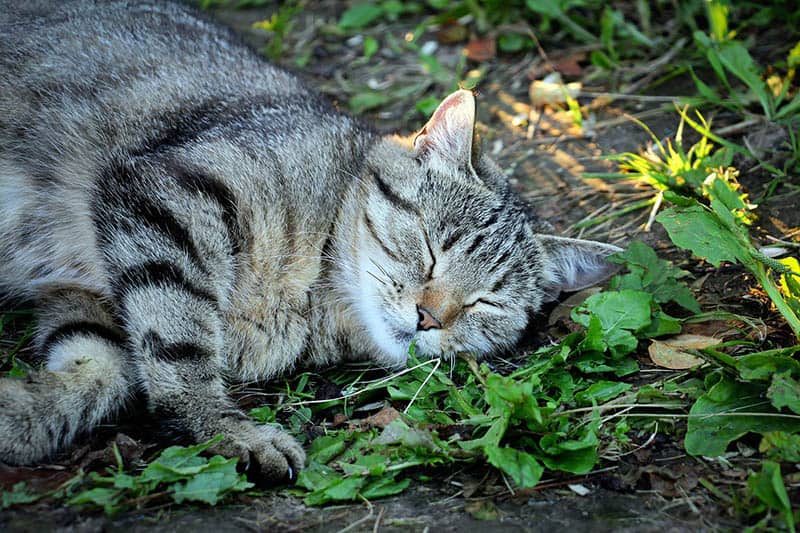Catnip (Nepeta cataria) is a small herb that grows naturally in Northern America, certain areas of Europe, and East Asia. Catnip has widely documented effects on house cats due to their reactions to Nepetalactone, the oil released by the catnip plant when its stem or leaves are bitten or crushed.
This oil also positively affects bigger cats, including the largest ones in the Panthera family (lions, leopards, and jaguars, and to a certain extent, tigers), as well as smaller “big “cats such as cougars and bobcats, who all enjoy catnip’s relaxing and exciting effect, so yes, big cats do like catnip.
Big cats have the same reaction to the herb that small cats do due to it reacting with the big cat’s brains in the same way as smaller ones. Some research has stated that this reaction is seen in felines because of how feline sex pheromones smell, and it is reflected in the behavior seen in cats exposed to catnip; they will often roll, head rub, and lick or bite the leaves.
Big cats react so strongly to catnip that hunters and trappers even use it to bait traps set for bobcats and lynx, who can’t resist its smell. All felines also react to silvervine (Actinidia polygama) similarly.

Why Do Big Cats Like Catnip?
Like in other cats, catnip produces a euphoric effect in big cats such as lions and leopards, alongside relaxation and even potential hallucinations, due to its impact on the opioid system in the cat’s brain.
Nepetalactone enters the cat’s body through cells in the nose. It causes a chain of chemical reactions, ending in the release of hormones from the amygdala (the emotion center of the brain) alongside the release of endorphins which make the cat happy and relaxed.
This euphotic reaction only lasts around 15 minutes, however, and after this, a big cat can’t react to catnip again for approximately an hour due to the body’s “cool-down” period.
Another reason why big cats might like catnip is because of nepetalactones’ insect-repelling abilities. Cats will roll around in catnip to release the Nepetalactone, which has been seen in research to be more helpful in repelling biting insects such as mosquitos than DEET (a commercial insect repellent) and may have an evolutionary advantage for the cat.

Do Zoos and Animal Parks Use Catnip?
Some zoos, sanctuaries, and rescues use catnip for enrichment purposes for their felines, big and small. Most species will react positively to it, enjoying the effects and giving visitors to the parks something to coo over.
One study has shown that other substances can also be used for enrichment for big cats in exposures, such as cinnamon, chili powder, and cumin, which are particularly effective when used in conjunction with other enrichment sources, such as frozen fish.
One zoo in the UK uses discarded Christmas trees as enrichment for their lion population, stating that “(the trees) are almost like catnip.”
What Other Animals Are Attracted to Catnip?
Research shows that only felines react to catnip in a euphoric, relaxed way. The effects of catnip have been tested on several animal species, including mice, birds, rabbits, and dogs, all of which show no reaction.
Reactions have been observed in many wild and big cats. Research shows that the reaction of the following felid species has been documented:
- Lions
- Leopards
- Jaguars
- Bobcats
- Oncilla Cats
- Lynx
- Cougars
- Cheetahs
- Pallas Cats
- Black Footed Cats
- Tigers (to a lesser extent)


Final Thoughts
Big cats like catnip just as much as house cats do and have the same silly, giddy reactions to it. This is very useful in research and conservation, as catnip is used to provide enrichment for the cats in captivity, improves their overall well-being, and is an inexpensive way to vary their day-to-day lives. Big cats like catnip because of how it reacts with their brains; it releases endorphins and other pleasant hormones, causing a reaction like a cat in heat.
Featured Image Credit: Ceuline, Pixabay
